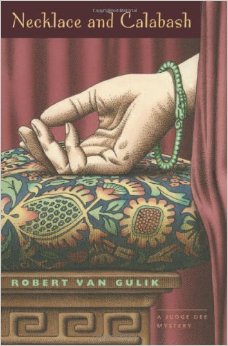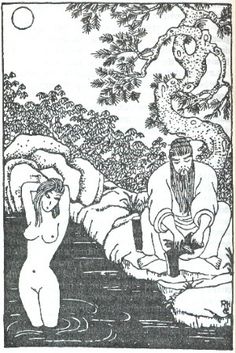 Necklace and Calabash
Necklace and Calabash
Robert van Gulik
First published in 1967 by Heinemann
This edition University of Chicago Press, 1992
ISBN: 9780226848709
152 pages
Judge Dee was a real historical figure who lived in China from 630 to 700AD, under the T’ang dynasty. He was a renowned detective, magistrate, and later a statesman.
Robert van Gulik was a Dutch diplomat and scholar who during World War II translated the 18th-century detective novel Dee Goong An as Celebrated Cases of Judge Dee. Inspired by its success he published 16 original books featuring Dee between 1951 and 68 (the first if which was initially published in Japanese). Necklace and Calabash was the penultimate title and is my entry for the #1967book challenge.
Necklace and Calabash opens with an encounter in the woods. Dee is travelling across country to Rivertown to relax and do some fishing, but has managed to get lost. He is helped on his way by a Taoist monk called ‘Master Gourd’, who also gives him something to think about:
‘What have you got in that calabash?’
‘Emptiness, sir. Just emptiness […] Emptiness is more important than fullness. You may choose the finest clay for making a beautiful jar, but without its emptiness that jar would be of no use.’
The Rivertown police chief, Captain Siew, recognises the famous magistrate as soon as he arrives in town, and suggests that Dee might like to help him out with some undercover work. The town is neutral territory for two criminal gangs – the Blue League and the Red League – which causes Captain Siew a lot of trouble. He could really do with Dee’s advice on how to drive the gangs out.
Rivertown is under military law because it hosts an imperial dwelling – the Water Palace. Captain Siew explains the set-up:
The highest authorities here are three officials, two civil and one military. The Chief Eunuch is responsible for the Third Princess, her court-ladies and all their womenfolk. Then we have the Palace Superintendent who is responsible for the rest of the personnel, a thousand persons in all. My chief, Colonel Kang, is the Commander of the Guard.
Dee soon gets dragged into palace politics. The Third Princess, favourite daughter of the Emperor, has been robbed in slightly embarrassing circumstances. She asks Dee to act on her behalf to find the thief – but nobody must know.
And to cap it all, things are just as bad at Dee’s inn. The innkeeper’s wife has eloped and one of the servants has been fished out of the river after being tortured to death.
Dee has three cases on his hands, and in all of them he has to act unofficially. He spends much of the book incognito. Initially he disguises himself as a doctor, then later picks up the role of a lieutenant in a criminal gang. The need to be undercover makes his job very difficult – especially as you can be summarily executed for putting a foot wrong when dealing with the Imperial family.
The book is full of historical interest (although in his notes, van Gulik basically admits that he played fast and loose with his time periods).
One example: When Dee visits the Third Princess he is in his role as a doctor, and he has to pretend to examine a lady-in-waiting who suffers from asthma – just by looking at her hand.
Doctors are not allowed to see more of a distinguished lady-patient than her hand, and must diagnose the illness from the condition of the pulse.

Van Gulik produced his own illustrations for his books, including this one: ‘Judge Dee scrubs his boot with unnecessary vigour’.
(Hence the cover illustration.) Staying with illustrations, van Gulik produced some lovely line art for his books in a traditional Chinese style. Dee has three wives at home, but nonetheless finds himself targeted by the innkeeper’s niece Fern, who does her level best to use him as a means to escape her life of drudgery. I feel that van Gulik rather enjoyed drawing Fern – see left – and I note he also published collections of erotic art…
One final thing to mention are some fine action scenes, in which both the Judge and Master Gourd show off their martial arts.
Overall, a very enjoyable short novel, and something a little bit different.
A grumpy note: I really take issue with the number of typos in this edition. OK, I know a lot of e-books are produced cheaply by scanning and skip the proof-reading stage, but this is a) a book from a big-name publisher, and b) £7.56. That’s a lot of money for nobody checking it through. An automated spell-check would have caught most of the problems. Shame on you, University of Chicago Press.
See also:
Classic Mysteries: Necklace and Calabash is my favorite of the Judge Dee books. There are three major mysteries expertly interwoven here. Judge Dee, who is ably assisted by a team of aides in most of the other books, is on his own in Rivertown and must form new alliances. All this takes place against a backdrop of imperial China. Van Gulik, who was a Dutch diplomat, was an authority on Chinese history and culture, and his insight into what life may have been like in Judge Dee’s time adds a fascinating subtext to the book. I can’t recommend this one highly enough.
Final destination: A keeper

Past Offences by Rich Westwood is licensed under a Creative Commons Attribution-NonCommercial-NoDerivs 3.0 Unported License.



Glad you enjoyed it, Rich. It remains my favorite among the Judge Dee books. You might also want to try one of his early books – I’d recommend “The Chinese Lake Murders” as another one well worth your reading time.
LikeLike
Thanks Les – I have the Chinese Bell in my TBR.
LikeLike
I’ve read a couple of the Dee books and enjoyed them. Can’t think why I haven’t read more. Your excellent account may have prompted me to do something about this.
Have you seen the Chinese/HK movie Detective Dee and the Mystery of the Phantom Flame (2010)? It’s a tremendous romp, featuring a rather different characterization of Dee. I gather that Young Detective Dee: Rise of the Sea Dragon (2013) is done in similar spirit.
LikeLike
I caught some of the 2010 film late at night – agree it is quite a different kettle of fish.
However there is a proper martial arts combat scene in this book – featuring the classic trope of an elderly man suddenly proving to be a master.
LikeLike
I’ve heard of them, but never seen them. I may have to break down and find the first one anyway!
LikeLike
Really nice review, Rich. I got a Judge Dee free in ebook somewhere but yet to read it. Not really a locale I jump at to read.
LikeLike
Speaking of Judge Dee films, the novel The Haunted Monastery (1961) was adapted as a TV film titled Judge Dee And The Monastery Murders (1974) with an all Asian cast.
LikeLike
Pingback: Book of the month: March 2015 | Past Offences Classic Crime Fiction